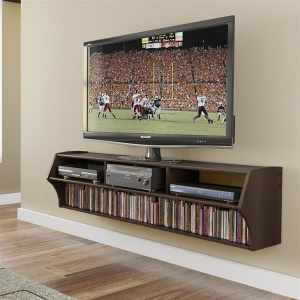mount a tv on the wall. Every day it is more common to mount the television on the wall instead of placing it on the furniture. On the one hand, the main reasons are the limitation of space and, on the other hand, the aesthetic issue. The televisions that are bought are getting bigger and bigger, so there is often not enough space in the furniture to place it, so sometimes there is only the option of leaving it hanging on the wall.
Also, as we say, the decision is made to mount the TV to the wall due to a design issue and the possibility of moving it from one side to the other with a bracket with an arm.
Whatever the reason, in this tutorial, we will explain the basic steps to follow, to place a television on the wall and do it correctly and safely. We will guide you to choose the right bracket according to the TV and the type of wall.
However, always follow the guide provided by the media manufacturer.
In this guide, we will explain the different types of supports that there are, which one to choose according to your television, and what to fix to know if the wall will be able to withstand the weight load.
Table of Contents
What kind of mount a tv on the wall to choose?

There are mainly three different types of supports. These are fixed stand, tilt, and full-motion stand.
The decision to choose one or the other will depend on where you plan to place the television and from where you are going to watch it.
Fixed supports
The fixed supports are the ones that tend to be closest to the wall, leaving in some cases less than 2 cm of separation. This type of support does not allow the screen to move. It is the most convenient if you see it entirely from the front and at eye level.
Tilting stands
The supports that are tiltable do allow the screen to move vertically and leave it tilted downwards. It is ideal if you see it from a lower height than it would be hung. In many televisions, as soon as the television is no longer entirely viewed from the front, the image quality begins to lose, and it may look more washed out.
Using a tilt stand, you will get the screen facing you, improving your vision when you see it, for example, from the bed.
Articulated Full Motion Bracket
In this case, the support includes an arm that can move horizontally and also allows tilt. This is the best option if you do not see the television from the front, but you see it from a corner.
Materials needed to mount the TV on the wall.
Once you have chosen the support, it is time to assemble. But for this, you need some tools.
-
Drill:
You will also need to have the appropriate bits.
-
Tape measure:
You will need it to ensure the distances between the holes and to take measurements of the height you want the TV to be on the wall.
-
Screws:
These usually come in the bracket box, but they may not be compatible, so you may have to buy them at a hardware store.
-
Studs:
In some models, they already include. However, it is advisable to buy specific ones for the type of wall you will put it.
-
Screwdrivers:
It is necessary to be able to fix the bracket to the back of the television. Conveniently, you have both stars and planes.
-
Bubble level:
In many cases, the stand itself already includes a built-in level.
Steps for mounting the TV on the wall
Before starting the installation, if you had planned to hang it yourself, it is better that you ask for a hand since, especially if the television is large, one person alone cannot do it.
Later, if you plan to hide the cables, you will probably have to cut a hole before mounting the TV to pass them. There is a wide range of conduits and gutters to route and conceal wiring. There are various materials such as plastic extrusion, aluminum, and even steel in different sizes and colors.
Some brackets with an arm also can pass the cables through it to prevent them from being seen hanging.
Before starting, an important detail is to know where to make the holes to avoid drilling pipes and electrical cables. For this, a cable detector can be helpful as it detects if there are pipes and cables. To do this, you have to pass the sensor through the wall. Of course, keep in mind that if the wall is very thick and the device is not excellent, it may not be very reliable.
If you are not going to mount the television on a brick wall, but instead, you will mount it on a plasterboard wall, you have to find the profiles. The gaps between these bars will be hollow and will not support the weight of the television. These vertical beams run the length of the walls and usually place 600mm or 450mm apart. Look for the metal profiles with a detector, so you know where they are located.
Fix the bracket: mount a tv on the wall
Once this is done, fix the bracket to the wall and mark where the screw holes are. When drilling the holes, use the level to set the stand straight and drill the holes using the appropriate bit for the bracket. Place some suitable plugs for the type of wall to get better support. Check with the hardware store for the correct studs.
After already attach the bracket to the wall, now it’s time to fix it to the TV. Depending on the TV model, it has a different screw size. For example, those used by Samsung are usually thicker (M8 in general) than those of Sony or LG.
They do not come in the television box, but in the stand, they do. However, the length tends to fall short in many cases, especially in some Samsung models that require a very long screw.
If possible, connect the cables to the TV as it can be more complicated later. Using the screws already suitable for your television. Attach the bracket to the four holes on the back of the television. Each bracket uses a system to join the parts of the rack. And here, it would be nice to have the help of someone else. When they already attach and attaches, tighten the screws to leave everything finally fixed.
Also Read: How to make a diaper cake











